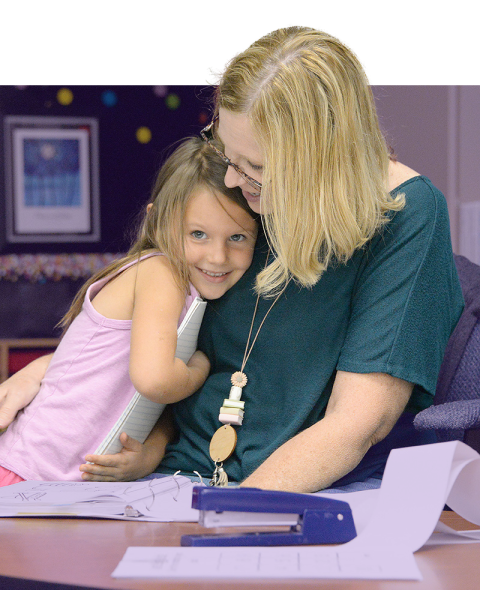214 1st Avenue NE
Buffalo, MN 55313
United States
Special Services
Information and Resources
Disability Information
The Individuals with Disabilities Education Act (IDEA) is the federal law that defines and regulates special education. The law requires public schools to provide special education services to children birth to 21, who meet certain criteria.
IDEA covers 13 types of disabilities:
Autism Spectrum Disorder (ASD)
A behaviorally defined group of disorders characterized by an uneven developmental profile and a pattern of qualitative impairments in social interaction, communication and repetitive and stereotyped patterns of behavior, interests and activities, with onset in early childhood.
Developmental Cognitive Disability (DCD)
Significantly sub-average general intellectual functioning resulting in or associated with concurrent deficits in adaptive behavior: either, Mild to Moderate (MMI) or Severe-Profound (MSMI).
Developmentally Delayed (Early Childhood Special Education, Birth through Age 6 only)
A substantial delay or disorder in development or an identifiable sensory, physical, cognitive, social/emotional conditions or other conditions known to hinder normal development.
Emotional/Behavioral Disorder (EBD)
An established pattern of interaction characterized by one or more of the following:
severely aggressive behavior impulsive behaviors severely withdrawn behaviors anxious behaviors generally pervasive unhappiness depression severe mood swings severely disordered thought processes manifested by unusual behavior patterns, atypical communication styles or distorted interpersonal relationships.
Other Health Disabilities (OHD)
A broad range of medically diagnosed chronic and associated acute health conditions that adversely affect educational performance to the extent special education and related services may be needed.
Physically Impaired (PI)
A medically diagnosed chronic physical impairment, either congenital or acquired, that adversely affects physical or academic functioning
Severely Multiply Impaired (SMI)
Student has severe learning and developmental problems resulting from two or more disabling conditions. Students with severe multiple impairment (SMI) meet the criteria for two or more of six categorical areas: deaf or hard of hearing, physically impaired, developmental cognitive disability (severe/profound), visually impaired, emotional or behavioral disorders and autism spectrum disorders.
Specific Learning Disability (SLD)
A condition in which a significant discrepancy between one’s general intellectual ability and academic achievement in one or more of the following areas:
- Oral expression
- Listening comprehension
- Mathematical calculation
- Mathematical reasoning
- Basic reading skills
- Reading comprehension
- Written expression.
*A significant discrepancy is about two years below age/grade level expectations given average cognitive abilities.
*The student's underachievement is not primarily the results of visual, hearing, or motor impairment; developmental cognitive disabilities; emotional or behavioral disorders; environmental, cultural, or economic influences; limited English proficiency; or a lack of appropriate instruction in reading or math.
Speech/Language Impairment (SLI)
A communication disorder in fluency, voice, articulation or language.
Traumatic Brain Injury (TBI)
An acquired injury to the brain caused by external physical force, resulting in total or partial functional disability or psychosocial impairment, or both, that adversely affects a child’s educational performance.
Deaf and Hard of Hearing (D/HH)
Audiological documentation provided by a certified audiologist of documented hearing loss that affects educational performance.
Deaf-Blind (D/B)
The combination causes severe communication and other developmental and educational needs.
Blind - Visual Impairment (BV/I)
Documentation of visual impairment by licensed eye specialist. According to Minnesota Rules 3525.1345, "'Visually impaired' means a medically verified visual impairment accompanied by limitations in sight that interfere with acquiring information or interaction with the environment to the extent that special education instruction and related services may be needed." A student with visual impairments and a functional need may be considered for special education under the Blind – Visually Impaired (BVI) category.
Resources
For further information, you may contact any of the following organizations:
ARC Minnesota (Advocacy for Persons with Developmental Disabilities)
651.523.0823
1.800.582.5256
Minnesota Association for Children’s Mental Health
651.644.7333
1.800.528.4511
Minnesota Disability Law Center
612.334.5970 (Twin Cities Metro)
1.800.292.4150 (Greater Minnesota
612.332.4668 (TTY)
PACER (Parent Advocacy Coalition for Educational Rights)
952.838.9000
1.800.53-PACER
952.838.0190 (TTY)
Minnesota Department of Education
651.582.8689
651.582.8201 (TTY)


